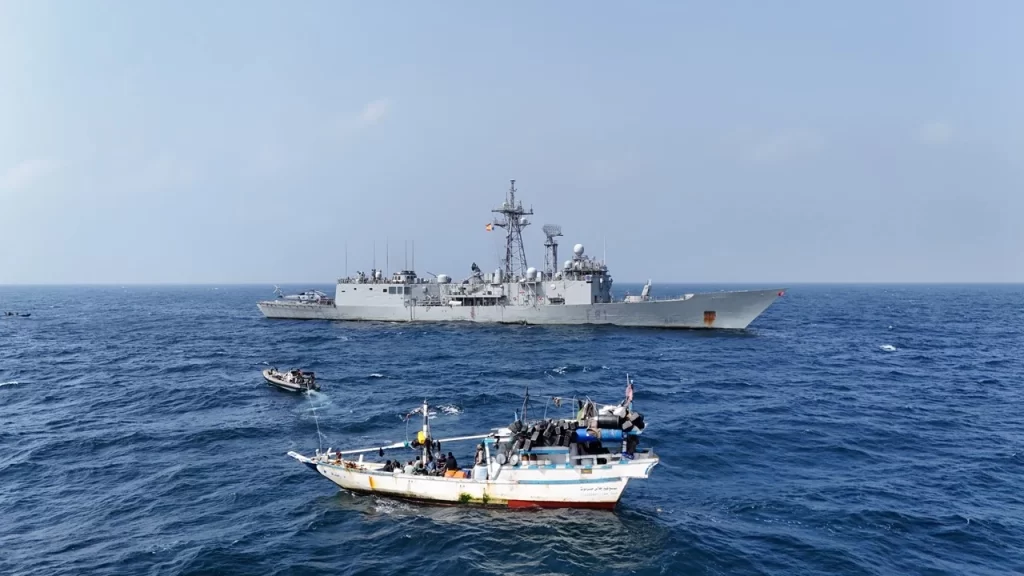Why do negotiations with Somali Pirates Fail in the High-Stakes Chess?
Piracy in the Indian Ocean, particularly off the coast of Somalia, has never been a random occurrence. It is a structured, profit-driven enterprise built upon desperation, criminal ingenuity, and strategic execution. The recent hijacking of the Yemeni fishing vessel Al Najma, coupled with the Indian Navy’s dramatic rescue of the Bulgarian ship Ruen, has once again thrust the complex issue of pirate negotiations into the global spotlight. The question remains: How do you negotiate with men who have nothing to lose but everything to gain?
Psychology, economics, and realpolitik intersect to provide the answer. While pirate attacks may seem like chaotic acts of violence, they operate on predictable patterns, using extortion-based negotiation models that exploit vulnerabilities in maritime security frameworks. This article delves into the mechanics of these negotiations, dissecting past failures, real-time challenges, and the strategic pivots needed to combat this enduring maritime threat.
Understanding the Somali Pirate Business Model
One must first understand the operational and financial structure of Somali piracy. Piracy off Somalia follows an economic model akin to venture capitalism. Initial investment, risk assessment, return on investment, and negotiation tactics are all part of a sophisticated ecosystem.
The Somali Pirate Playbook: How They Hijack Ships in 30 Minutes
A typical pirate operation costs between $15,000 and $50,000. This includes procuring skiffs, weapons, satellite phones, fuel, and logistics. Investors, often local warlords or financiers from the Somali diaspora, fund these operations in exchange for a significant share of the ransom. Once they target a vessel, pirates gather intelligence from informants at ports, maritime databases, or even from corrupt insiders within shipping firms. A successful hijacking takes as little as 30 minutes.
The Ransom Breakdown: Who Gets What in a Pirate Payout?
Pirates categorize ship owners based on their willingness and ability to pay. Initial ransom demands often exceed $10 million and are later negotiated down to $3–5 million over a few weeks or months. The ransom is typically paid in cash, dropped by helicopter onto the deck of the hijacked ship. A breakdown of the ransom distribution includes:
- 60% goes to the financiers and organizers.
- 30% to the hijackers and foot soldiers
- 5% to local administrators and tribal elders
- • 5% goes toward payments for corruption, ensuring the continuation of operations.
This highly structured model ensures piracy remains an attractive business, as it can yield up to a 3,000% return on investment, making it one of the most lucrative criminal enterprises globally.
Why Negotiating with Pirates is a Losing Game
Not all negotiations end with a smooth transaction. The failures often stem from fundamental misunderstandings of how Somali pirates operate.
Unlike business disputes where contracts and legal frameworks guide discussions, piracy negotiations lack an agreed-upon moral or legal compass. Pirates operate under no fear of contractual breaches or reputational damage. Their only leverage is the hostages, and their only interest is maximizing ransom. Similarly, piracy negotiations are unlike conventional hostage situations where a government negotiates with terrorists for ideological or political concessions. For pirates, it is purely financial. Pirates never compromise; they either pay the ransom or threaten lives.
On the other hand, Somali pirate groups exploit time as a weapon. The longer negotiations last, the more desperate the shipping company becomes, pushing up the ransom price. Cases like MV Iceberg 1, where hostages were held for three years, illustrate how protracted negotiations can be brutal for the victims. This is also because Pirates understand psychological warfare. Threats of execution, staged violence, and even real harm to crew members serve as pressure tactics to push negotiations toward their demands. The tragic case of Beluga Nomination, where a hostage was killed after a botched rescue attempt, underscores the deadly stakes.
Piracy 2.0: How Somali Pirates Are Adapting to Modern Countermeasures
Somali piracy peaked in 2011, costing the global economy an estimated $7 billion annually. The response was a mix of armed deterrence, international naval patrols, and defensive shipping measures. The numbers dropped sharply, but recent incidents indicate a resurgence.
Why? Pirates, like any business operator, adapt.
Countries like Greece and Italy, which have historically paid large ransoms, inadvertently fueled the piracy economy. By allowing pirates to dictate terms without unified resistance, they emboldened future attacks.
The lack of a stable central government in Somalia creates an ideal environment for piracy to thrive. Local clan elders often shield pirate groups, benefiting from ransom money funneled into their communities. It is also pertinent to note that Pirates have learned to categorize hostages based on their nationality and employer, demanding varying ransom amounts. A European or American crew member fetches a higher price than an Indian or Filipino sailor.
While military rescues are risky, well-executed operations (such as the Indian Navy’s commando drop on Ruen) prove that overwhelming force, when used surgically, can neutralize pirate threats without massive collateral damage.
Why Military Force Alone Can’t Solve the Piracy Problem
Shipping companies, insurers, and maritime security forces must establish a coordinated response system. A standing crisis management team should dictate a fixed ransom ceiling to prevent pirates from inflating their demands. At the same time, instead of outright refusing to pay ransoms (which could endanger lives), authorities should focus on tracking and intercepting ransom money post-payment, thereby crippling pirate networks financially.
Using satellite tracking, social media monitoring, and informant networks, naval forces must intercept pirate operations before they reach the hijacking stages. Intelligence sharing between entities like EUNAVFOR ATALANTA, CMF, and regional coast guards is critical. Also, negotiators should exploit Somali tribal dynamics, offering incentives to rival clans that oppose piracy. Psychological tactics, like disinformation campaigns about ransom payments or threats of targeted strikes, can disrupt pirate cohesion.
Success in Somali piracy negotiations is determined by tactical patience, intelligence superiority, and economic countermeasures. The resurgence of piracy underscores the need for an adaptive, coordinated response— not just in terms of military strength but also in understanding the psychology and economics of piracy.

